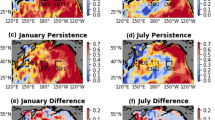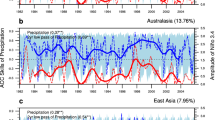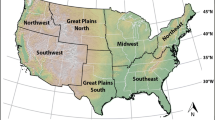Abstract
An ensemble statistical forecast scheme with a one-month lead is developed to predict year-to-year variations of Changma rainfall over the Korean peninsula. Spring sea surface temperature (SST) anomalies over the North Atlantic, the North Pacific and the tropical Pacific Ocean have been proposed as useful predictors in a previous study. Through a forward-stepwise regression method, four additional springtime predictors are selected: the northern Indian Ocean (NIO) SST, the North Atlantic SST change (NAC), the snow cover anomaly over the Eurasian continent (EUSC), and the western North Pacific outgoing longwave radiation anomaly (WNP (OLR)). Using these, three new prediction models are developed. A simple arithmetic ensemble mean produces much improved forecast skills compared to the original prediction model of Lee and Seo (2013). Skill scores measured by temporal correlation and MSSS (mean square error skill score) are improved by about 9% and 17%, respectively. The GMSS (Gerrity skill score) and hit rate based on a tercile prediction validation scheme are also enhanced by about 19% and 13%, respectively. The reversed NIO, reversed WNP (OLR), and reversed NAC are all related to the enhancement of a cyclonic circulation anomaly to the south or southwest of the Korean peninsula, which induces southeasterly moisture flux into the peninsula and increasing Changma precipitation. The EUSC predictor induces an enhancement of the Okhotsk Sea high downstream and thus strengthening of Changma front.
Similar content being viewed by others
References
Adler, R. F., and Coauthors, 2003: The version 2 Global Precipitation Climatology Project (GPCP) monthly precipitation analysis (1979 -present). J. Hydrometeor., 4, 1147–1167, doi:10.1175/1525-7541(2003)004<1147:TVGPCP>2.0.CO;2.
Blockeel, H., and J. Struyf, 2002: Efficient algorithms for decision tree cross-validation. J. Mach. Learning Res., 3, 621–650, doi:10.1162/jmlr.2003.3.4-5.21.
Chen, X., and T. Zhou, 2014: Relative role of tropical SST forcing in the 1990s periodicity change of the Pacific-Japan pattern interannual variability. J. Geophys. Res., 119, 13043–13066, doi:10.1002/2014JD-022064.
Chu, J.-E., S. N. Hameed, and K.-J. Ha, 2012: Non-linear, intraseasonal phases of the East Asian summer monsoon: Extraction and analysis using self-organizing maps. J. Climate, 25, 6975–6988, doi:10.1175/JCLI-D-11-00512.1.
Ding, R. Q., K.-J. Ha, and J. P. Li, 2010: Interdecadal shift in the relationship between the East Asian summer monsoon and the tropical Indian Ocean. Climate Dyn., 34, 1059–1071, doi:10.1007/s00382-009-0555-2.
Kanamitsu, M., W. Ebisuzaki, J. Woollen, S. K. Yang, J. J. Hnilo, M. Fiorino, and G. L. Potter, 2002: NCEP-DOE AMIP-II Reanalysis (R-2). Bull. Amer. Meteor. Soc., 83, 1631–1643, doi:10.1175/BAMS-83-11-1631.
Kim, J.-Y., and K.-H. Seo, 2014: The development of Ensemble Statistical Prediction Model for Changma precipitation. Korean Meteor. Soc., 24, 533–540, doi:10.14191/Atmos.2014.24.4.533 (in Korean with English abstract).
Kwon, M., J.-G. Jhun, B. Wang, S.-I. An, and J.-S. Kug, 2005: Decadal change in relationship between east Asian and WNP summer monsoons. Geophys. Res. Lett., 32, L16709, doi:10.1029/2005GL023026.
Lee, E.-J., J.-G. Jhun, and C.-K. Park, 2005: Remote connection of the northeast Asian summer rainfall variation revealed by a newly defined monsoon index. J. Climate, 18, 4381–4393, doi:10.1175/JCLI3545.1.
Lee, S.-E., and K.-H. Seo, 2013: The development of a statistical forecast model for Changma. Wea. Forecasting, 28, 1304–1321, doi:10.1175/WAF-D-13-00003.1.
Lee, S.-S., J.-Y. Lee, K.-J. Ha, B. Wang, and J. Schemm, 2011: Deficiencies and possibilities for long-lead coupled climate prediction of the western North Pacific-East Asian summer monsoon. Climate Dyn., 36, 1173–1188, doi:10.1007/s00382-010-0832-0.
Matsumura, S., K. Yamazaki, and T. Tokioka, 2010: Summertime land atmosphere interactions in response to anomalous springtime snow cover in northern Eurasia. J. Geophys. Res., 115, D20107, doi:10.1029/2009JD012342.
Matsumura, S., K. Yamazaki, and T. Sato, 2015: Role of Siberian land atmosphere coupling in the development of the August Okhotsk High in 2008. J. Meteor. Soc. Japan, 93, 229–244, doi:10.2151/jmsj.2015-013.
Oh, H., and K.-J. Ha, 2016: Prediction of dominant intraseasonal modes in the East Asian-western North Pacific summer monsoon. Climate Dyn., 47, 2025–2037, doi:10.1007/s00382-015-2948-8.
Park, H.-L., K.-H. Seo, and J.-H. Son, 2015: Development of a Dynamics-Based Statistical Prediction Model for the Changma Onset. J. Climate, 28, 6647–6666, doi:10.1175/JCLI-D-14-00502.1.
Reynolds, R. W., T. M. Smith, C. Liu, D. B. Chelton, K. S. Casey, and M. G. Schlax, 2007: Daily high-resolution-blended analyses for sea surface temperature. J. Climate, 20, 5473–5496, doi:10.1175/2007JCLI1824.1.
Robinson, D. A., K. F. Dewey, and R. R. Heim, 1993: Global snow cover monitoring: An update. Bull. Amer. Meteor. Soc. 74, 1689–1696, doi:10.1175/1520-0477(1993)074<1689:GSCMAU>2.0.CO;2.
Seo, K.-H., J.-H. Son, and J.-Y. Lee, 2011: A new look at Changma. Korean Meteor. Soc., 21, 109–121 (in Korean with English abstract).
Seo, K.-H., J.-H. Son, J.-Y. Lee, and H.-S. Park, 2015: Northern East Asian monsoon precipitation revealed by air mass variability and its prediction. J. Climate, 28, 6221–6233, doi:10.1175/JCLI-D-14-00526.1.
Wang, B., R. Wu, and X. Fu, 2000: Pacific-East Asian teleconnection: How does ENSO affect East Asian Climate? J. Climate, 13, 1517–1536, doi:10.1175/1520-0442(2000)013<1517:PEATHD>2.0.CO;2.
Wang, B., J.-G. Jhun, and B.-K. Moon, 2007: Variability and singularity of Seoul, South Korea, rainy season (1778-2004). J. Climate, 20, 2572–2580, doi:10.1175/JCLI4123.1.
Wang, B., B. Xiang, and J.-Y. Lee, 2013: Subtropical high predictability establishes a promising way for monsoon and tropical storm predictions. Proc. Natl. Acad. Sci. USA, 110, 2718–2722, doi:10.1073/pnas.1214626110.
Wilks, D. S., 2006: Statistical Methods in the Atmospheric Sciences. 2nd ed. Academic Press, 630 pp.
Wu, Z., B. Wang, J. Li, and F.-F. Jin, 2009: An empirical seasonal prediction model of the east Asian summer monsoon using ENSO and NAO. J. Geophys. Res., 114, D18120, doi:10.1029/2009JD011733.
Xie, S.-P., K. Hu, J. Hafner, H. Tokinaga, Y. Du, G. Huang, and T. Sampe, 2009: Indian Ocean capacitor effect on Indo-western Pacific climate during the summer following El Niño. J. Climate, 22, 730–747, doi:10.1175/2008JCLI2544.1.
Yang, J., Q. Liu, S.-P. Xie, Z. Liu, and L. Wu, 2007: Impact of the Indian Ocean SST basin mode on the Asian summer monsoon. Geophys. Res. Lett., 34, L02708, doi:10.1029/2006GL028571.
Yim, S.-Y., J.-G. Jhun, R. Lu, and B. Wang, 2010: Two distinct patterns of spring Eurasian snow cover anomaly and their impacts on the East Asian summer monsoon. J. Geophys. Res., 115, D22113, doi:10.1029/2010JD013996.
Yim, S.-Y., B. Wang, and W. Xing, 2014: Prediction of early summer rainfall over South China by a physical-empirical model. Climate Dyn., 43, 1883–1891, doi:10.1007/s00382-013-2014-3.
Yim, S.-Y., B. Wang, and W. Xing, 2015: Peak-summer East Asian rainfall predictability and prediction part II: Extratropical East Asia. Climate Dyn., 47, 15–30, doi:10.1007/s00382-015-2849-x.
Yun, K.-S., K.-H. Seo, and K.-J. Ha, 2008: Relationship between ENSO and northward propagating ISO in the East Asian summer monsoon system. J. Geophys. Res., 113, D14120, doi:10.1029/2008JD009901.
Author information
Authors and Affiliations
Corresponding author
Rights and permissions
About this article
Cite this article
Kim, JY., Seo, KH., Son, JH. et al. Development of statistical prediction models for Changma precipitation: An ensemble approach. Asia-Pacific J Atmos Sci 53, 207–216 (2017). https://doi.org/10.1007/s13143-017-0027-2
Received:
Accepted:
Published:
Issue Date:
DOI: https://doi.org/10.1007/s13143-017-0027-2




